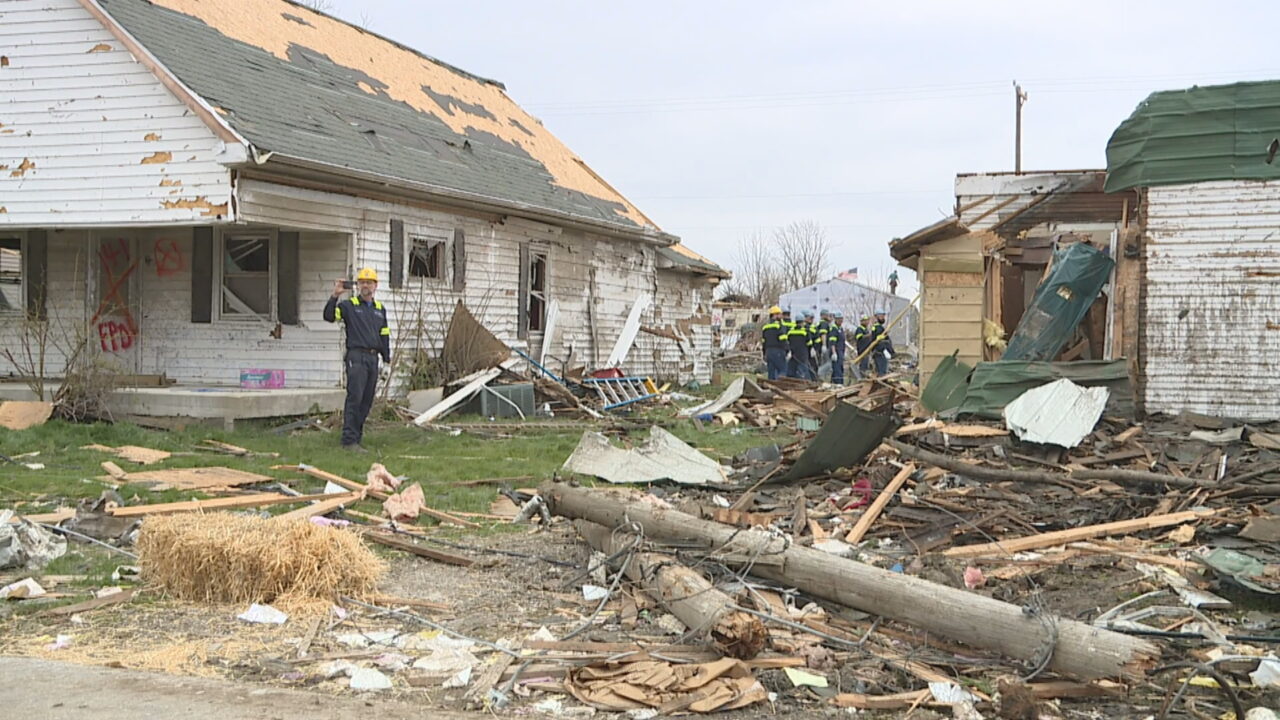Was your home damaged in a tornado? Here’s what to do next
(AP) — Deadly storms in the past two weeks have unleashed dozens of tornadoes in the United States, mainly in the South and Midwest, killing at least 63 people and damaging or destroying hundreds of people’s homes.
- What we know about 22 tornadoes that hit Indiana on March 31 – April 1, 2023
- Weather service confirms tornado in Montgomery County
- Sen. Braun: Federal help likely for Sullivan tornado recovery
- I-Team 8: Storm damage creates opportunity for scammers
This year’s early severe weather, especially in the Midwest, is part of a trend seen over the past few years, according to Bill Bunting, chief of forecast operations at the National Weather Service Storm Prediction Center in Norman, Oklahoma.
“We are entering the time of the year where the potential for severe weather increases and much more of the U.S. becomes at risk,” Bunting said this week in an email.
An average of 1,200 tornadoes hit the country yearly, and the United States will probably get more killer supercells spawning tornadoes and hail as the world warms, according to a recent study.
That study also warns the lethal storms will edge eastward to strike more frequently in populous Southern states like Alabama, Mississippi, and Tennessee. But tornadoes can happen any time of year and have been reported in all 50 states, according to NOAA’s National Severe Storms Laboratory.
What should you do if your home is destroyed or severely damaged, once you are safe?
FOCUS ON YOUR SAFETY
The word people most commonly use to describe their mindset after a natural disaster is “overwhelmed,” according to United Policyholders, a nonprofit that advocates for insurance consumers.
“Our basic guidance is to first focus on you and your family’s safety,” said Amy Bach, United Policyholders’ executive director.
Next, if possible, she recommends photographing and documenting damaged and destroyed property — without entering severely damaged buildings — and determining whether further damage can be prevented through the use of tarps, fans or other methods.
Finding safe and comfortable temporary shelter and getting a copy of your current insurance policy are important next steps. When you’re safe, have an idea of the extent of your home’s damage, have shelter, and notify your insurance company.
HOW’S YOUR INSURANCE?
Tornado damage is generally covered under homeowner’s and renter’s insurance policies. But you’ll want to read your insurance policy to know your deductible costs and what is covered, Bach said. If damage is minor to moderate, it might not cost as much to repair as the deductible in your policy.
“We tell people not to rush and to instead take stock and get situated before making any decisions,” she said. “Know that you’ll get solicited (by contractors), and in the first 48 hours, the shock and the trauma generally means you’re not in your best decision-making mode.”
For temporary, immediate housing, people often turn to a shelter opened by a local government, the American Red Cross or other organizations.
In addition to providing a place to sleep, water and meals, Red Cross services — all of which are free — can sometimes also include child care, information about disaster-related resources in the community, and access to case workers to help you with disaster recovery.
People also may need to access insurance to cover longer-term housing, for rebuilding a home and/or replacing belongings, including vehicles.
Keep receipts for hotel bills, clothing and meals while displaced, and take notes on the calls you make to insurance companies, including the numbers you call, the people spoken to, dates and times, and what was said.
KEEP UP PAYMENTS
If your residence is temporarily uninhabitable or destroyed, the Red Cross recommends notifying utility companies and other services so they can stop billing you immediately. Paying insurance premiums and rent or mortgage should be your highest priority, according to the Red Cross.
Call any creditors and ask for more time to pay. Most creditors will be willing to work with you, especially if you notify them before a payment is due, the Red Cross said.
Overall, most people have a very steep learning curve after a tornado or other natural disaster because people think they’ll be OK if they have insurance.
“But for many people, that’s just one piece of getting back as close to where you were,” Bach said. “Losing a home is very much like a death in the family.”
The Red Cross also has a section on its website dedicated to recovering emotionally after a disaster.
“Try to accept whatever reactions you may have,” the organization advises on the website. “Look for ways to take one step at a time and focus on taking care of your disaster-related needs and those of your family.”
